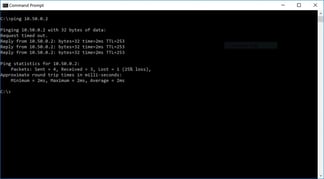
The reason the first ping usually fails is that the remote router in that LAN has to put the ping request on hold to send out an ARP broadcast to learn the MAC address of the remote device, then wait for a response, and then send the first ping through. This delay is usually too long. That’s why the initial ping request from your PC times out and declares that the ping failed.
Subsequent ping requests are successful because the ARP cache in the remote router is now valid, and the request can go all the way through.
This first ping failing is not a defect in the network, as there is no fault to remedy, it is normal for networks to operate this way.
However, if the remote device has been communicated with in the past five minutes, the ARP information is still in the remote router’s ARP cache. In this case, the first ping might not fail.
Note: If you are pinging a router’s own interface, there is no ARP cache that needs to be updated, as the router knows its own interface. In this case, the first ping should always reply successfully.
PathSolutions TotalView covers all of these bases, ensuring the best operating environment for your Network.
Click here to download the Fact Sheet in standard PDF format.
Interested in learning more?
info@pathsolutions.com
©2024 PathSolutions Inc. All rights reserved.